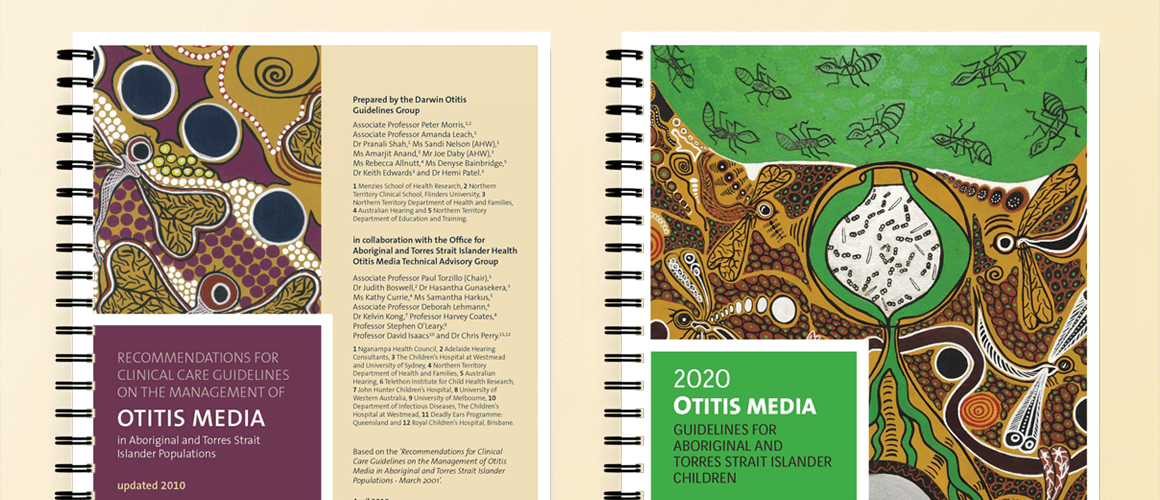Scan the QR code to download the Otitis Media Guidelines App
How are the 2020 Otitis Media Guidelines different from the Department of Health’s “2010 Recommendations for Clinical Care Guidelines on the Management of Otitis Media in Aboriginal and Torres Strait Islander Populations”?

The 2020 Otitis Media Guidelines are an update of the 2010 Guidelines. The update of the Guidelines has been overseen by the same core group of ear and hearing health professionals via the Menzies School of Health Research. For an overview of what’s new in the 2020 Guidelines see PDF.
QUALITY –––––––––– A GRADE approach to evidence synthesis and quality assessment is used.
RISK LEVEL ––––––––– Targeted recommendations for both high– and low-risk children.
SURGERY ––––––––––– New section on tympanostomy tube (Grommets) otorrhoea, TTO.
PRIORITY SERVICES –– Five priority conditions for children’s services
TREATMENT –––––––– Antibiotics strongly recommended for persistent otitis media with effusion in high- risk children.
TREATMENT –––––––– Azithromycin strongly recommended for acute otitis media where adherence is difficult or no refrigeration access.
REFERRALS ––––––––– Concurrent audiology and ENT referrals where delays are likely.
REFERRALS ––––––––– ENT referral for chronic suppurative otitis media at the time of diagnosis.
TREATMENT –––––––– Option of autoinflation for some children with persistent otitis media with effusion.
HEARING LOSS –––––– Substantial revisions in audiological assessment and management.
HEARING LOSS CATEGORIES –––––––– Revised definitions for moderate hearing impairment as > 30 dB according to WHO disabling hearing loss for children.
OMAPP & ONLINE ACCESS ––––– New multi-platform downloadable ‘OMapp’ enables free fast access to the 2020 OM Guidelines, plus images, animations and multiple Aboriginal and Torres Strait Islander language audio translations to aid communication with families. Menzies School of Health Research. Otitis Media Guidelines for Aboriginal and Torres Strait Islander children. 2020.
Can I use the Otitis Media Guidelines for non-Aboriginal and Torres Strait Islander children?
Yes, the 2020 Otitis Media Guidelines and app are applicable to all children. You just need to follow the high- or low-risk prompts to obtain the appropriate guidance.
Will the 2020 Otitis Media Guidelines be updated in the future?
Yes, we are always keeping an eye out for new relevant research findings that will have an impact on the Otitis Media Guidelines. We are currently reviewing how best to update the Guidelines, whether this be the whole document, or one section as a time. Watch this space!
How do I reference the 2020 Otitis Media Guidelines in my work?
Our summary article in the Medical Journal of Australia outlines the 2020 OM Guidelines and contains all relevant links for app downloads:
Leach AJ, Morris P, Coates HLC, et al. Otitis media guidelines for Australian Aboriginal and Torres Strait Islander children: summary of recommendations. Med J Aust 2021; 214 (5): 228-233
Which resources and manuals are currently informed by the 2020 Otitis Media Guidelines?
The current 7th edition of the CARPA Manual (clinic manual for primary health care practitioners in remote and Indigenous health services in central and northern Australia) is informed by the 2020 Otitis Media Guidelines and was updated in collaboration with members of the OM Guidelines Technical Advisory Group.
The predecessor of the 2020 Otitis Media Guidelines, the “2010 Recommendations for Clinical Care Guidelines on the Management of Otitis Media in Aboriginal and Torres Strait Islander Populations” currently informs a range of manuals, resources and policies, including:
– “An Aboriginal Ear Health Framework for South Australia” The Government of South Australia Audiology Australia Position Statement – Hearing health of Aboriginal and Torres Strait Islander peoples
-“Infants and Children, Otitis Media: Acute Management of Sore Ear, Second Edition” Government of New South Wales
– “Chronic Otitis Media and Hearing Loss Practice” Manual, Audiology Australia, March 2012
– “WA Child Ear Health Strategy 2017-2021” Government of Western Australia, AHCWA, Rural Health West, Telethon Kids Institute and WAPHA
– “Antibiotic use in children with acute otitis media” RAGCP gplearning resource
– “Ear disease in Aboriginal and Torres Strait Islander children” Closing the Gap Clearinghouse, Australian Government Australian Institute of Health and Welfare, Australian Institute of Family Studies, November 2014
– “Aboriginal, Torres Strait Islander and Pacific Islander Ear Health Manual” The Garnett Passe and Rodney Williams Memorial Foundation
As these various resources get updated we anticipate inclusion of reference to the new 2020 Otitis Media Guidelines.
How do I offer my own suggestions and feedback on the Otitis Media Guidelines and app?
We always welcome any feedback and suggestions that our users have, both for future releases of the OM Guidelines and regarding the features and useability of the OMapp. Please contact us by email via CRE_ICHEAR@menzies.edu.au.

